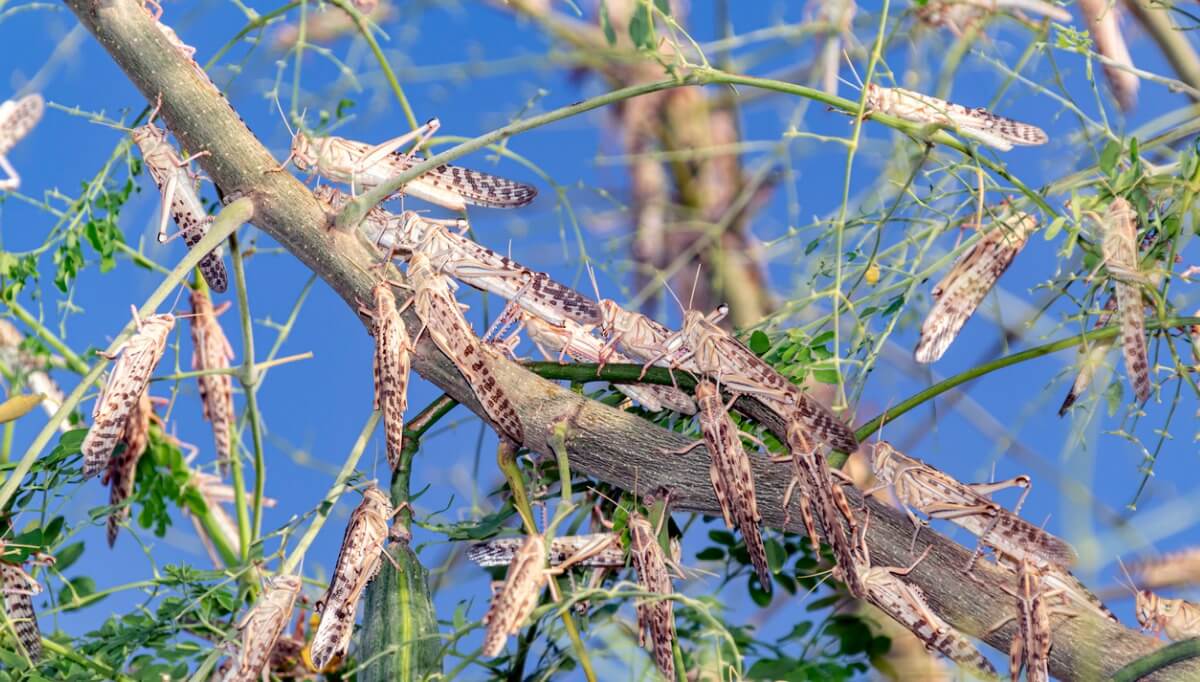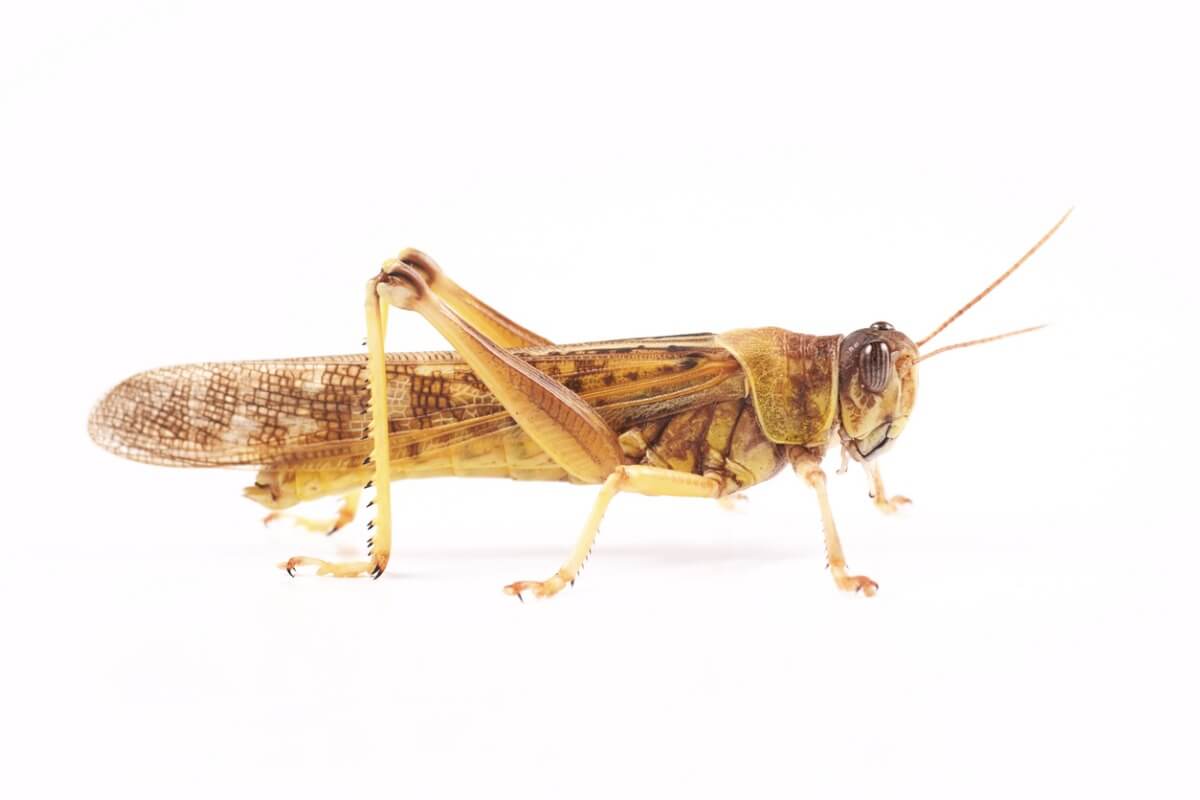10 Curiosities About Locusts


Written and verified by the biologist Samuel Sanchez
The curiosities about locusts are almost endless, as they’re one of the few invertebrates with a massive migratory capacity. We go further, as they are even capable of modifying their brain and body according to their vital phase.
These insects are impressive physically and numerically, but, unfortunately, they can cause untold losses of food and crops, especially in the most vulnerable low-income countries. Get to know 10 curiosities about locusts and you’ll see that they’re as fascinating as they’re socially problematic. Don’t miss it!
1. Locusts are grasshoppers
Before entering fully into the world of locust curiosities, it’s necessary to contextualize them from a taxonomic point of view. These invertebrates are orthopteran insects, but they also belong to the Caelifera suborder and the Acrididae family. Simply put, they occupy the same phylogenetic position as grasshoppers.
There are about 11,000 species of grasshoppers and some of them are locusts, but not all locusts are grasshoppers. To be considered as such, these insects must have an unusual vital strategy within their group: migration. Only a few that can be considered as “true locusts” strictly meet this definition.
The main species of locusts are Locusta migratoria, Schistocerca gregaria and Chortoicetes terminifera. There are approximately 30 of them.

2. They big insects
There’s no taxonomic distinction between locusts and grasshoppers, but this doesn’t mean that they don’t have certain physical differences. In their solitary phases, locusts are much larger than many of their relatives, as they easily reach 6 centimeters (2.2 inches) in length in the case of females.
Beyond this, locusts have highly developed wings, ready-to-jump hind limbs, complex mouthparts for cutting up plant material, and body colors ranging from greenish-brown to yellow. As we’ll see below, these traits depend on the phase the insect is.
3. Locusts are migratory insects
The curiosities about locusts are multiple, but, without a doubt, their most notable is their ability to form migratory swarms. In normal situations these insects are solitary, but when certain characteristics occur (drought and later plant growth), the flow of serotonin in their body varies drastically.
In moments of stimulation, these animals begin to breed rampantly, giving rise to nuclei of nymphs, which later develop into winged adults. These powerful specimens will fly between terrains, destroying all the crops they find in their path and overlapping several generations to expand as much as possible.
Lobsters have a solitary phase and a migratory swarm phase.
4. The change during migration is cerebral and hormonal
Studies have shown that, in the migratory Locusta species, the change from solitary phase to swarm period is mediated by adjustments in the brain. According to research, this is achieved by the methylation of DNA present in brain cells. When overactive, the Dnmt3 gene promotes the acceleration of the animal’s metabolism.
In addition, the contact between many specimens (overpopulation) promotes the release of serotonin, which accelerates their cycle.
5. Locusts don’t only change their habits, but also their appearance
When their brain and serotonin circuitry match, locusts eat, reproduce, and develop much faster. However, their changes aren’t only behavioral, they also report very striking variations on a physical level.
The locust species Locusta migratoria, in their solitary phase, are large and greenish in color, as they need to blend in with the surrounding vegetation. On the other hand, swarm specimens have a reduced bearing and their body tonality changes a lot. It turns almost garish yellow with black backgrounds.
The phenotype (appearance) of the specimen is reversible depending on the phase that its population requires.

6. An unusual mobility
The fact that locusts have such developed wings isn’t a coincidence. The swarms reach quite high speeds when they carry out their migratory movements, reaching even 20 kilometers per hour.
The Schistocerca gregaria species flies in the direction of the wind to save energy and, in its migratory movement, it’s capable of traveling 150 kilometers in a single day. In addition, the specimens of the swarm can take flight above more than 2000 meters above sea level.
7. The swarm numbers are intimidating
Depending on the species, the number of locusts per swarm can vary. In any case, this ranges between 20 and 150 million per square kilometer. These insects literally form a cloud in the skies that emits a loud roar with their wings. Without a doubt, this apocalyptic vision is intimidating even to the bravest.
Each lobster can consume its own weight in plant matter in 24 hours.
8. Migratory pests
Another of the locusts’ curiosities is the extent of their migratory phenomenon. Each species follows its own pattern of distribution, but, without a doubt, Schistocerca gregaria is one of the most problematic at an economic and social level.
During periods of recession in the swarms, the range of this species is confined to a “belt” of 16 million square kilometers that extends from Mauritania to the Indian region. As populations grow and several generations of locusts are born, up to 60 countries can be affected by migratory pests.
The area that these swarms can occupy is 32 million square kilometers, or 20% of the earth’s surface.
9. Irreparable damage
These insects are polyphagous (they eat various parts of plants) and are capable of consuming their own weight in plant matter in just 24 hours. If this figure is multiplied to the 80 million winged specimens that usually move per square kilometer of land, it is easy to understand why locust pests are a real health, economic and social problem.
To put the figures in context, National Geographic indicates that a swarm the size of Paris is capable of eating in a single day the same amount of food as half of the human population present in all of France. Only 1 square kilometer of locusts consumes the same as 35,000 people in the aforementioned time interval.
10. A life cycle incompatible with humans
More than simply one of the curiosities of locusts, this last point requires a necessary reflection. While it’s true that all living beings deserve respect, it’s impossible to reconcile the swarms of these species with the survival of certain human population groups, especially those vulnerable that depend on agriculture.
The war against locusts continues to this day, and, fortunately, biopesticides have been developed that are very effective and relatively safe for the environment, as they selectively attack problem species (such as the Metarhizium acridum fungus). Unfortunately, there are very harmful biological cycles that can’t be solved and pose a great ethical conflict.
The curiosities about locusts are almost endless, as they’re one of the few invertebrates with a massive migratory capacity. We go further, as they are even capable of modifying their brain and body according to their vital phase.
These insects are impressive physically and numerically, but, unfortunately, they can cause untold losses of food and crops, especially in the most vulnerable low-income countries. Get to know 10 curiosities about locusts and you’ll see that they’re as fascinating as they’re socially problematic. Don’t miss it!
1. Locusts are grasshoppers
Before entering fully into the world of locust curiosities, it’s necessary to contextualize them from a taxonomic point of view. These invertebrates are orthopteran insects, but they also belong to the Caelifera suborder and the Acrididae family. Simply put, they occupy the same phylogenetic position as grasshoppers.
There are about 11,000 species of grasshoppers and some of them are locusts, but not all locusts are grasshoppers. To be considered as such, these insects must have an unusual vital strategy within their group: migration. Only a few that can be considered as “true locusts” strictly meet this definition.
The main species of locusts are Locusta migratoria, Schistocerca gregaria and Chortoicetes terminifera. There are approximately 30 of them.

2. They big insects
There’s no taxonomic distinction between locusts and grasshoppers, but this doesn’t mean that they don’t have certain physical differences. In their solitary phases, locusts are much larger than many of their relatives, as they easily reach 6 centimeters (2.2 inches) in length in the case of females.
Beyond this, locusts have highly developed wings, ready-to-jump hind limbs, complex mouthparts for cutting up plant material, and body colors ranging from greenish-brown to yellow. As we’ll see below, these traits depend on the phase the insect is.
3. Locusts are migratory insects
The curiosities about locusts are multiple, but, without a doubt, their most notable is their ability to form migratory swarms. In normal situations these insects are solitary, but when certain characteristics occur (drought and later plant growth), the flow of serotonin in their body varies drastically.
In moments of stimulation, these animals begin to breed rampantly, giving rise to nuclei of nymphs, which later develop into winged adults. These powerful specimens will fly between terrains, destroying all the crops they find in their path and overlapping several generations to expand as much as possible.
Lobsters have a solitary phase and a migratory swarm phase.
4. The change during migration is cerebral and hormonal
Studies have shown that, in the migratory Locusta species, the change from solitary phase to swarm period is mediated by adjustments in the brain. According to research, this is achieved by the methylation of DNA present in brain cells. When overactive, the Dnmt3 gene promotes the acceleration of the animal’s metabolism.
In addition, the contact between many specimens (overpopulation) promotes the release of serotonin, which accelerates their cycle.
5. Locusts don’t only change their habits, but also their appearance
When their brain and serotonin circuitry match, locusts eat, reproduce, and develop much faster. However, their changes aren’t only behavioral, they also report very striking variations on a physical level.
The locust species Locusta migratoria, in their solitary phase, are large and greenish in color, as they need to blend in with the surrounding vegetation. On the other hand, swarm specimens have a reduced bearing and their body tonality changes a lot. It turns almost garish yellow with black backgrounds.
The phenotype (appearance) of the specimen is reversible depending on the phase that its population requires.

6. An unusual mobility
The fact that locusts have such developed wings isn’t a coincidence. The swarms reach quite high speeds when they carry out their migratory movements, reaching even 20 kilometers per hour.
The Schistocerca gregaria species flies in the direction of the wind to save energy and, in its migratory movement, it’s capable of traveling 150 kilometers in a single day. In addition, the specimens of the swarm can take flight above more than 2000 meters above sea level.
7. The swarm numbers are intimidating
Depending on the species, the number of locusts per swarm can vary. In any case, this ranges between 20 and 150 million per square kilometer. These insects literally form a cloud in the skies that emits a loud roar with their wings. Without a doubt, this apocalyptic vision is intimidating even to the bravest.
Each lobster can consume its own weight in plant matter in 24 hours.
8. Migratory pests
Another of the locusts’ curiosities is the extent of their migratory phenomenon. Each species follows its own pattern of distribution, but, without a doubt, Schistocerca gregaria is one of the most problematic at an economic and social level.
During periods of recession in the swarms, the range of this species is confined to a “belt” of 16 million square kilometers that extends from Mauritania to the Indian region. As populations grow and several generations of locusts are born, up to 60 countries can be affected by migratory pests.
The area that these swarms can occupy is 32 million square kilometers, or 20% of the earth’s surface.
9. Irreparable damage
These insects are polyphagous (they eat various parts of plants) and are capable of consuming their own weight in plant matter in just 24 hours. If this figure is multiplied to the 80 million winged specimens that usually move per square kilometer of land, it is easy to understand why locust pests are a real health, economic and social problem.
To put the figures in context, National Geographic indicates that a swarm the size of Paris is capable of eating in a single day the same amount of food as half of the human population present in all of France. Only 1 square kilometer of locusts consumes the same as 35,000 people in the aforementioned time interval.
10. A life cycle incompatible with humans
More than simply one of the curiosities of locusts, this last point requires a necessary reflection. While it’s true that all living beings deserve respect, it’s impossible to reconcile the swarms of these species with the survival of certain human population groups, especially those vulnerable that depend on agriculture.
The war against locusts continues to this day, and, fortunately, biopesticides have been developed that are very effective and relatively safe for the environment, as they selectively attack problem species (such as the Metarhizium acridum fungus). Unfortunately, there are very harmful biological cycles that can’t be solved and pose a great ethical conflict.
All cited sources were thoroughly reviewed by our team to ensure their quality, reliability, currency, and validity. The bibliography of this article was considered reliable and of academic or scientific accuracy.
- Falckenhayn, C., Boerjan, B., Raddatz, G., Frohme, M., Schoofs, L., & Lyko, F. (2013). Characterization of genome methylation patterns in the desert locust Schistocerca gregaria. Journal of Experimental Biology, 216(8), 1423-1429.
- Robinson, K. L., Tohidi‐Esfahani, D., Ponton, F., Simpson, S. J., Sword, G. A., & Lo, N. (2016). Alternative migratory locust phenotypes are associated with differences in the expression of genes encoding the methylation machinery. Insect Molecular Biology, 25(2), 105-115.
- Lange, A. B., Wang, Z., Orchard, I., & Starratt, A. N. (1996). Influence of methylation or substitution of the histidine of HVFLRFamide on biological activity and binding of locust oviduct. Peptides, 17(3), 375-380.
This text is provided for informational purposes only and does not replace consultation with a professional. If in doubt, consult your specialist.








